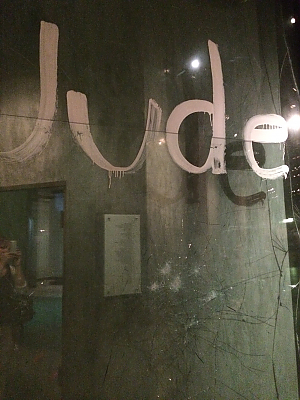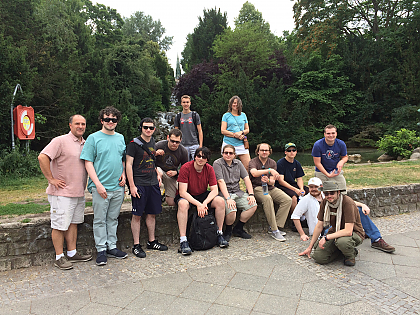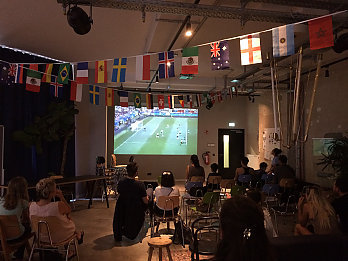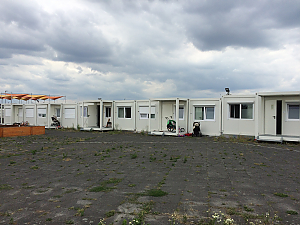Our First Days in Berlin
We have now had two days of our new routine: class in the morning, field trips in the afternoon, exploring by evening, and doing reading and homework. Below are some pictures from our visits to "The Story of Berlin" and the Schwerbelastungskorpor, and Tempelhof Field. I have also included some student journal entries. The group is doing very well.
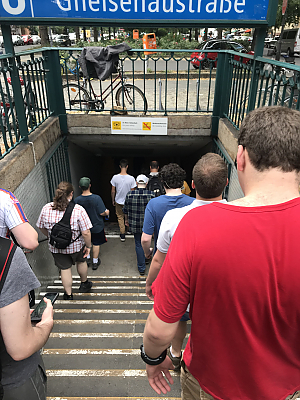
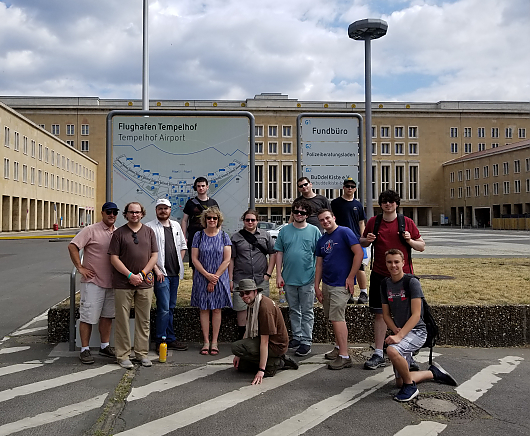
In the Story of Berlin museum, there was an interesting take on the era of World War II. Pre-World War II history was on the first floor and separated into neat and tidy sections but then when World War II came about, the viewer was led down stairs that seemed to go further and further. When you got to the era of the Nazis, the tone of the museum changed. The floor starts out as book bindings leaning down a slanting hallway past gigantic red banners with scenes of the era. Then there was a glass window, as if from a shop, with the word Jude spray-painted on it. The glass was broken as if by a rock or a hammer and when you walked past it the sound of breaking glass began to play. This made it very real for me. I used to look at history objectively and knew the stories through text books in class and movies. This brought about the terror and the emotional trauma of the era more than any story or textbook could. It was a very well done exhibit, showing and capturing the horror and persecution that was happening and holy fish monkeys did it scare me. I recorded the scene in order to try to capture just what was going on.
Matthew M Ward
Today in the Story Of Berlin museum, I learned what a huge difference layout and non-informational details can have on a museum’s teaching effectiveness. When going down the stairs, seeing all the notable people that the Nazi regime uprooted or killed I felt a sense of horror. The stairs seemed to say that this was an evil and irrevocable downward spiral for Germany and the rest of the world. The stairs kept going down and The lights and paint got dimmer and dimmer as I started to hear crunching sounds from below. Once at the bottom I saw dozens of ceramic book tiles and I finally thought I understood what the ominous crinkling sound was. As I saw it the crinkling was the knowledge being crushed, metaphorically. The crinkling was really from a vandal’s destruction of a window but I feel like the glass was a really good effective touch whatever the true meaning was intended to be. It also was good museum design to make to pre and post world war section the biggest and most impactful as that’s how it seems to me.
Luke Valentine
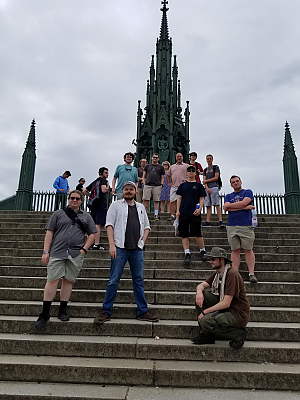
In the short time that I have experienced it so far, Berlin has proven to be a fascinating city. It was founded at a key mercantile juncture – a narrow point in a wide river valley – sometime during the late 12th century. As a result, Berlin naturally became a beacon of cosmopolitan modernity throughout its history. However, the focus of this course is placed squarely on the lowest points of this city: the rise and rule of the oppressive Nazi regime and the fallout that resulted from its collapse. The museum that we visited today, The Story Of Berlin, expertly showcased these highs and lows through a detailed history of the city, starting from its foundation and continuing through to the modern day. Everything here appeared to have been given precise consideration, up to the construction of the museum itself. The exhibits and showcases were set up along a physical incline that angled upwards, with an exhibit showcasing the city's cosmopolitan peak in the 1920s at the top. The next exhibit showcasing the rise of Nazi party was placed in a stairwell leading sharply downwards. This lent a physicality to the rise of the city as a cosmopolitan haven, as well as the sharp downfall into the capitol of a fascist state. The exhibit eventually brings the visitors back up with the city, using an ascending elevator to transition into the destruction of the Berlin Wall, leading, of course, into the gift shop. (I'm not entirely sure what this final part symbolizes; it could potentially be a self-aware comment on the hegemony of commercialism over the western world – but that might be a bridge too far.) This first day has left me excited to learn more about Berlin and dig deeper into the rich history of this eclectic city.
Adam Cook
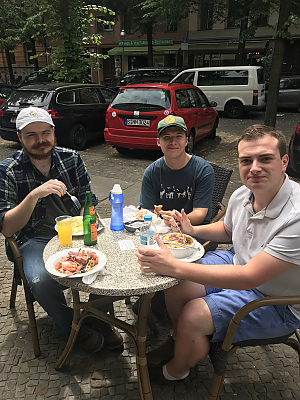
Adam, Jack and Chris at an outdoor Cafe
There is an embarrassment of riches in the food department in our neighborhood--from hundreds of small cafes, restaurants, and coffee shops to a large market, the Mahreineke Markt, one block from our campus. We even have our own little cafe on our campus, and a kitchen where we will cook a dinner together on Thursday.
On the eve of June 18th, 2018, I saw the most captivating performance of all time. No, this man did not eat a nuclear-powered sandwich on the verge of a meltdown, nor did this man balance on a thin strand of spaghetti while a six-foot-tall rodent tried to eat him. Those acts have already been done and have lost their charm, but this was something grand. This spectacular spectacle which transpired was so spectacular that words cannot describe the brilliant magnificence of this stunt; until now. I sat in a dark theater in awe; while a man pushed a big red ball back in fourth to a simple runtime of thirty-five minutes. At certain points, in his sheer will to wow us, he would dance on the ball to some music and juggle three smaller balls, but those moments were slow and utterly dull compared to the real excitement of him pushing the big red ball. Afterward, he engaged in a well-deserved break while the audience eagerly waits for him to do something.
I must confess I did not completely understand this performance of amazement and I found it quite bland at parts. To fully immerse myself in the experience, I took the liberty in conjuring up an interpretation to settle any misleading confusion. The act is about a man who is married to a big red ball who has three children that are smaller balls; called ballings. When the man goes to take a break, it means there's a turbulence in the relationship and they lost that passion they once shared. Then when music comes back on and he dances on top of his wife's body which indicates that they rediscovered their love. After the performance, the creator of this spectacle did a Q and A with the audience and announced he's planning on extending the runtime. I eagerly await to see one whole hour of a man pushing a red ball with sections in between of him drinking water. I wonder what life after this momentous occasion will be like. I theorize the world will forever be changed into a celestial body of peace and harmony over the next ten-thousand and one years.
Henry Tobias Mandler
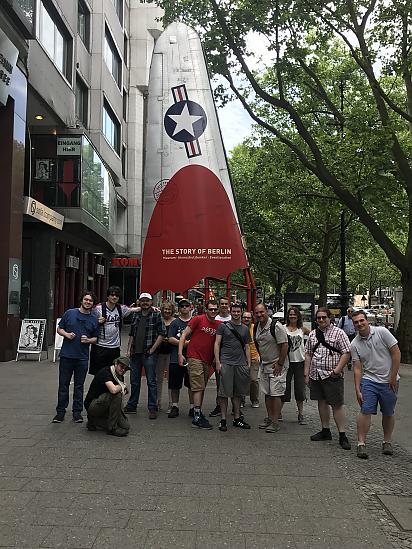
Today was only the first day of this three-week study abroad trip, and I felt like I learned a lot and had many great experiences today. After our class today, we took a trip to the Story Of Berlin museum. I learned so much about German history there. One of the most fascinating things I observed and learned about was the bunkers that originated during the Cold War. During a thirty-minute tour of the bunkers, I learned many interesting facts about them. For example, I learned that the bunkers were built in order to be a kind of safe zone in case of a nuclear bombing and that there are a couple that the people here still have around just in case it ever does happen. Seeing how the inside of the bunker looked made it more fascinating as well. I saw what the beds looked like, as well as the kitchens and bathrooms, which have more toilets for men and fewer for women by the way. Seeing all of this really intrigued me, as I got to learn facts like how people would have to prepare for living in a bunker for 2 weeks and live in said bunker for about the same amount of time. Seeing what the bunker and all the rooms and furniture in it looked like was helpful for me as well. I don’t know why, but something about seeing it just made it more fascinating for me. Part of me feels like it is because I am more of a visual learner, but another part tells me that looking at it all just makes me feel like I understand things a little more. Sure, I didn’t actually experience living in a bunker, but looking at the remains of one made me feel like I could just sense how it was a little for whoever had to live in one for a bit. But overall, it was one of my favorite parts of the trip we took today, and I look forward to learning a whole lot more on the next one.
Gus Zarefsky
Picture on the Right: Refugee Housing
Berlin has set aside part of the fields of the former Tempelhof Airfield to house refugees in these pre-fab buildings, up to 3000, we've been told.
We walked by today and could hear children playing and laughing, and see adults taking classes.
Christie
Did you ever think about that you would be able to view life under the Third Riech in Berlin differently than what history has told us? Nope, it was certainly a game changer for me and probably for people who see it World War II onesided. I have been in Berlin in less than 72 hours and I have already learned or been interested more with the exhibits of the museum, The Story Of Berlin, than previously. It was really interesting because the museum's exhibits were more about the getting the message across with a sense of either shock and awe or by showing enlarged pictures with one color being shown to draw attention which could convey a stern warning of what might happen next. For example, in the rise of the Nazi’s exhibit, after traveling down a flight of stairs to where the exhibit was in the museum. The first ten to fifteen feet of hallway flooring and edging was marked with book spines of what books or type of books that were destroyed by the Nazis in the early days of Hitler’s power. The last section of the hallway had vertical enlargements of photos showing people doing the Nazi salute and I walked past them like I was walking into the wolf’s lair where there was a personality cult. At the end of the hall was a huge piece of glass partly shattered with the Word “Jude” on it, making a reference to the Jews and other minorities who were persecuted from daily life under Hitler and forced to wear the star of David or any other insignia depending on who you were. Seeing the different insignia’s that Jews, Gypsies, Criminals, Political prisoners, Bible theologists, Homosexuals had to wear was something unknown to me because, in the United States, teachers barely touch on who was persecuted by the Nazi’s except Jews since more of them were persecuted and killed in the camps than other minorities. This exhibit has proved to be a real game changer in the end for me because I learned and understood more from one exhibit and from a different view than all of the books I’ve read in the past about the topic.
Jack Mundt
